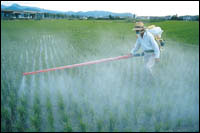What do you do when you want to move fast but the way ahead is dark, possibly dangerous, and almost entirely unknown? Accelerate? Proceed with moderation? Slow way down? Stop?

Don’t spray it.
That question underlies most environmental regulations. We are not sure what pesticides are doing to soils, waters, other creatures, or ourselves. We have only a vague idea what our rising greenhouse gas output will do to the climate. We’re in the dark about the consequences of genetic engineering. So should we go ahead? How fast?
U.S. policy, and that of most other countries, has ranged from acceleration to moderation. Often the cost has been revealed only decades later, in the form of poisoned wells, sickened rivers, unhealthy air, dying wildlife, deformed babies. Now some governments are saying it makes more sense to slow down or stop.
The go-slow policy is hotly discussed in Europe and in the United Nations, but it is rarely mentioned in the U.S. news. It is called the “precautionary principle.” The basic idea is familiar to everyone. An ounce of prevention is worth a pound of cure. Look before you leap. If you can’t afford to lose, don’t gamble.
Or as a scientific gathering in 1998 put it: “When an activity raises threats of harm to human health or the environment, precautionary measures should be taken even if some cause and effect relationships are not fully established scientifically.”
Or as Christine Todd Whitman put it, two months before George W. Bush appointed her to head the Environmental Protection Agency: “We must acknowledge that uncertainty is inherent in managing natural resources, recognize it is usually easier to prevent environmental damage than to repair it later, and shift the burden of proof away from those advocating protection toward those proposing an action that may be harmful.”
If she meant that, she may be a historic EPA director.
U.S. environmental policy is based not on the precautionary principle, but on “risk management.” That means balancing risks against benefits. If the benefits seem to outweigh the risks, full steam ahead. If a pesticide will give cancer to only one person in a million, but make a corporation a hundred million bucks, go for it.
There are two big problems with risk/benefit policy. The first is that those who bear the risk are rarely the ones who get the benefits. The second problem is that the benefits are usually much better known than the risks. It is astonishing how much we don’t know about what we are doing.
See, for example, an article by 17 scientists from six countries in a recent Science magazine that summarizes the literature on climate change. It cites facts like this: In the past 100 years human fossil fuel burning has raised the atmospheric concentration of carbon dioxide higher than it has been for the previous 420,000 years — and we’re still accelerating.
The article repeats over and over that we do not know what that means for the planet. “As we drift further away from the domain that characterized the preindustrial Earth system, we severely test the limits of our understanding of how the Earth system will respond,” say the authors. And “humans have affected virtually every major biogeochemical cycle, but the effects of these impacts on the interactions between these elemental cycles are poorly understood.”
So, push the accelerator pedal to the floor?
Another Science article in December surveys what we know about the effects of genetically engineered organisms (GEOs). This article is another ode to uncertainty. “Neither the risks nor the benefits of GEOs are certain or universal.” “Our ability to accurately predict ecological consequences, especially long-term higher-order interactions, increases the uncertainty associated with risk assessment.” “Additional or unidentified benefits and risks may exist that published data do not yet address.”
Should we turn hundreds of GEOs out of our labs and plant them on millions of acres of land?
Yet another recent Science article summarizes the findings of an expert panel on endocrine disrupters — hormone-mimicking chemicals, including many pesticides and plasticizers. The panel concluded that incredibly tiny concentrations of these chemicals — concentrations virtually all of us are exposed to — can cause development problems in rat and mouse embryos. The findings are especially disturbing, because they contradict the basic assumption underlying all toxics policy: that a low enough dose of any poison is essentially harmless.
But the studies were done on lab animals. “How these results may relate to disease late in life in animals, let alone humans, is uncertain,” says the article.
Shall we go on cranking out the chemicals?
Yes, say those who make money from them. No, says the precautionary principle. Plastics, pesticides, fossil fuels, gene-modified crops may make someone money and may save us all time or increase our convenience. But there are ways to proceed, probably more slowly, without them or with much less of them. It’s not worth risking human health or the planetary functions that sustain us, just to keep going fast.

